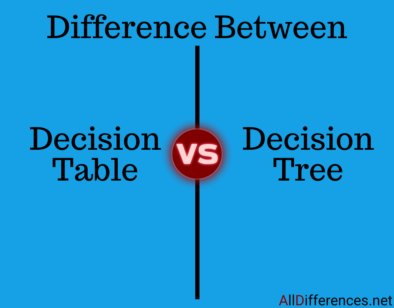Decision Table & Decision Tree
Contents
- Decision tables and decision trees are two popular methods used in decision-making and problem-solving.
- The key Difference Between Decision Table and Decision Tree is that Decision Table is just a tabular representation whereas Decision Tree is a graph representation.

Comparison Chart
- Decision Table and Decision Tree both have different features and functionalities, here is a comparison of some key features between them.
| Decision Table | Decision Tree | |
|---|---|---|
| Structure | Tabular | Graphical |
| Representation | Lists out possible conditions | Maps out possible outcomes |
| Format | Grid or matrix | Tree-like structure |
| Rows | Different combinations of conditions | Sequential decisions or conditions |
| Columns | Corresponding actions | Branches of possible outcomes |
| Complexity | Useful for complex scenarios | Useful for simple to moderate scenarios |
| Interdependence | Can account for overlapping or interdependent effects | Not as well-suited for interdependent factors |
| Decision-Making | Deals with all possible conditions and actions in one place | Requires following through branches to determine outcomes |
| Implementation | Can be implemented manually or through software | Typically implemented through software |
| Analysis | Suitable for rule-based analysis | Suitable for probability-based analysis |
Decision Table
- There are two types of decision tables:
- Extendedentry table
- Limitedentry table
Decision Table Advantages:
- Advantages:The table shows cause and effect relationships.
- Tables are of standardized format.
- Semi – standardized languages can be employed in these tables.
- Complex tables can easily be split into simpler tables.
- Table user’s are not required to possess computer knowledge.
Decision Table Disadvantages:
- Decision tables do not scale up well. We need to “factor” large tables into smaller ones to remove redundancy
- Total sequence – The total sequence is not clearly shown, i.e., no overall picture is given by decision tables as presented by flowcharts.
- Logic – Where the logic of a system is simple, flowcharts nearly always serve the purpose better than a decision table.
Decision Tree
- There are two types of decision tree.
- Categorical variable decision tree
- Continuous variable decision tree
Decision Tree Advantages:
- A decision tree is easy to understand and interpret.
- Expert opinion and preferences can be included, as well as hard data.
- Can be used with other decision techniques.
- New scenarios can easily be added.
Decision Tree Disadvantages:
- They are unstable, meaning that a small change in the data can lead to a large change in the structure of the optimal decision tree.
- They are often relatively inaccurate. Many other predictors perform better with similar data. This can be remedied by replacing a single decision tree with a random forest of decision trees, but a random forest is not as easy to interpret as a single decision tree.
- Calculations can get very complex, particularly if many values are uncertain and/or if many outcomes are linked
More Differences
- Difference Between Functional and Non functional Requirements
- Difference Between Gantt Chart and PERT Chart
